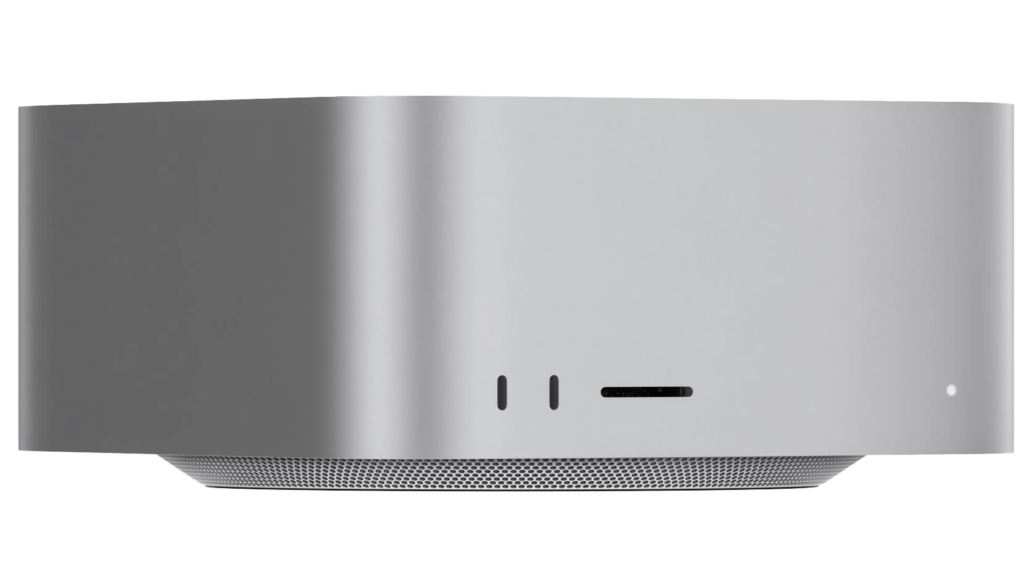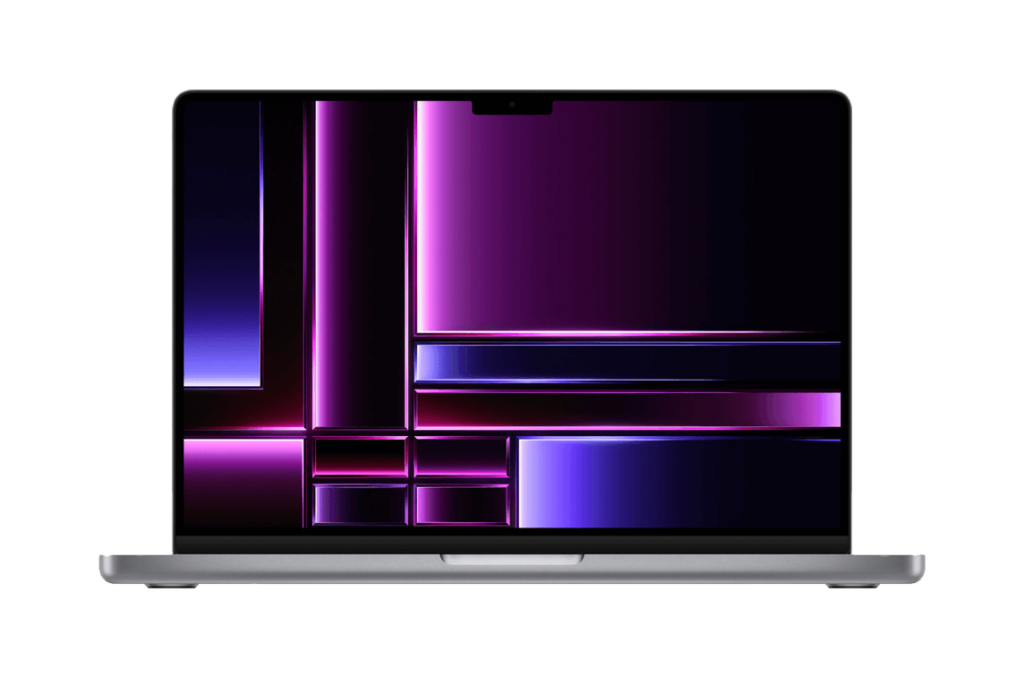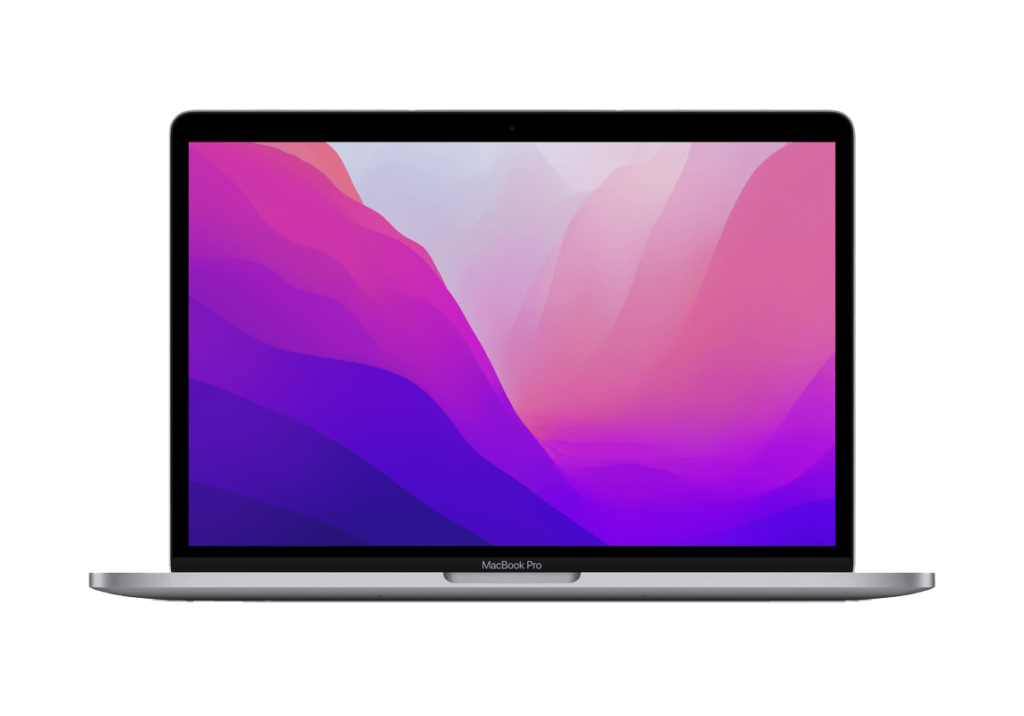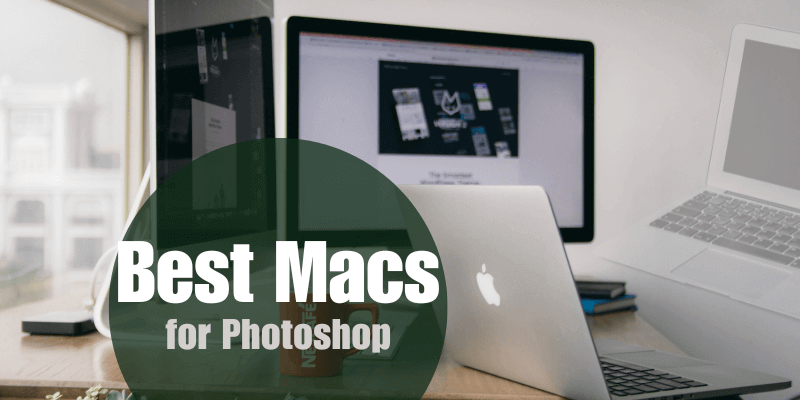As an Amazon Associate, I earn from qualifying purchases.
Macs have long been a favorite among creative professionals, but it can be difficult to sort through the tech details to find the best Mac for Photoshop. Many of the most powerful Macs are designed with features intended for high-quality video editing, but these can be a bit excessive for a standard Photoshop workflow. So how do you choose what’s right for you?
I started using Photoshop for the first time when it was still at version 5.5, way back in the days when iMacs were housed in brightly-colored plastic shells named after fruits, which suited them well since they were also round and juicy-looking – though hilariously gigantic by today’s standards. Since then, I’ve spent time working with Photoshop on a number of different Macs in the design and photography industries, and I can help you choose one that’s suited to your needs.
In this article, I’ll explain the features that are most helpful for Photoshop, why they matter to your workflow, and pick out three of the best Macs available for different users with different needs. Photoshop has a unique set of hardware requirements, so you might be surprised at some of the choices.
Table of Contents
Key Takeaways
- The most powerful Mac available is a Mac Pro, but most Mac Pro configurations are extremely expensive and overpowered for Photoshop use.
- The best desktop Mac for Photoshop is the Mac Studio with the M2 Max chip, since the M2 Ultra model is also a bit overpowered for Photoshop.
- For users who need a laptop solution, the 16-inch Macbook Pro provides the best Photoshop experience.
- If ultra-portability is your biggest concern, the 13-inch MacBook Pro has great capabilities in a small and lightweight frame.
How to Choose a Mac Computer for Photoshop
When choosing any computer specifically for Photoshop work, there are a few tech specs that matter more than others. Photoshop relies heavily on the CPU, but your available memory and the storage drive that you use as a scratch disk also have a major impact on performance.
Interestingly enough, in Photoshop benchmark testing run by workstation manufacturer Puget Systems, the system’s GPU had a much lower impact on performance than you might first expect. Beyond a certain point, a more powerful GPU doesn’t provide enough of a performance improvement to justify the added cost, which means that expensive workstation cards like the Nvidia RTX Quadro line are not a popular choice for Photoshop machines.
CPU / GPU
The CPU is where the majority of Photoshop processing is done, although some of Photoshop’s more advanced filters and effects are handled by the GPU. All of the Macs I’ve chosen use an Apple Silicon chip, meaning that the GPU is actually integrated into the CPU.
The crown jewel of the Apple Silicon chip hierarchy is the M1 Ultra that’s available in the Mac Studio, but according to testing done using Puget System’s PugetBench Photoshop benchmarking tool, it’s actually not much better for Photoshop than the M1 Max, despite being far more expensive.
Even in Apple’s own Photoshop performance data, the M1 Ultra only gets a slight bump in CPU-based tasks compared to the M1 Max. As a result, it doesn’t really make sense for most of you to spend the extra money on the more powerful chip unless you’ve got an unlimited budget and the need to save every single second possible.
That being said, the M1 Ultra does provide a huge boost over the M1 Max during importing and exporting from Lightroom, so that’s something else to consider if it’s part of your typical editing workflow, but it’s still difficult to justify the price increase for Photoshop alone.
RAM
The amount of random access memory (RAM) in your Mac affects how smoothly it will run when you’re working on multiple large Photoshop documents and running multiple apps. Photoshop requires a minimum of 8 GB of RAM to run, but with that amount, you’ll quickly run into performance issues if you want to run Lightroom or other apps in addition to Photoshop.
16 GB of RAM is a much better starting point for working with Photoshop and other apps, but if you have room in your budget, upgrading your RAM even further will make a big difference.
32 GB of RAM will provide you with a perfectly smooth experience, even if you’re working on multiple large files while running Lightroom, web browsers, and any other apps that you need for your workflow. If you want to make sure that your Photoshop machine is absolutely future-proof, 64 GB of RAM will give you room to grow, but it’s more than most people will ever need for photo editing.
Storage Drive
Many people are surprised to learn that the storage drives they use can have a big impact on Photoshop performance, but using a high-speed solid-state drive that connects using the PCIe interface can dramatically speed up your Photoshop usage. You should look for a minimum of 1 TB storage space so that you can install plenty of apps and store all your Photoshop documents while still keeping sufficient space free for the scratch disk.
Loading and saving large Photoshop documents is much faster when using a fast storage drive, but the biggest performance gains come from the improved scratch disk usage. If you’re unfamiliar with the term, Photoshop uses temporary storage space on your drive to keep track of extra data that doesn’t fit into RAM, such as history states and other data. If you want to learn more about scratch disks, Adobe has a quick primer on how they work.
Screen
The screen is one of the most important parts of your Mac, especially when you’re doing color-sensitive work. Your screen should be able to display 100% of the sRGB color space, which is used for all digital graphics. Ideally, it should also be able to display full coverage of the Adobe RGB color space that is used in high-end photography, but Apple has a history of ignoring this feature in their own displays in favor of the P3 color gamut used in the film industry.
To put that in plain English, if you choose one of the MacBook options listed below and you need to work in the Adobe RGB color space, you’ll also need to buy a secondary monitor to display the colors properly. The same is true of the Mac Studio, which isn’t sold with any monitor at all, presumably because Apple expects you to have a specific monitor requirement in mind.
I’ve never understood why they don’t just cover all of the popular color spaces with their own hardware, but I’m sure they have their reasons. Probably.
Bonus Features
Once you’ve covered the essential hardware details, there are often some nice additional features that can change your decision about which Mac is best for you. These can range from supporting complex multi-monitor setups to hardware features like the Touch Bar and Touch ID, although most of these features are not essential for your workflow.
The Best Macs for Photoshop Reviewed
I’ve sorted through the full range of Macs that are available from Apple and selected three different machines that fit a range of different needs so you can choose the perfect one for you.
While it might surprise some people, the Mac Pro is a bit overpowered for most Photoshop work since it’s intended for high-resolution video editing. It’s also extremely expensive, even in its base hardware configuration, so I didn’t include it as the best option.
Best Mac Desktop: Mac Studio (M2 Max Edition)

- CPU: Apple Silicon M2 Max, 38-core integrated GPU, configurable with the M2 Ultra
- RAM: 32 GB, configurable up to 96 GB
- Storage Drive: 512 GB PCIe solid-state drive, configurable up to 8 TB
- Screen: Not included
- Bonus Features: Supports up to 5 displays
The Mac Studio is a compact machine that manages to pack in a huge amount of processing power for Photoshop. The Mac Studio has enough power for all but the most demanding Photoshop workloads, although most users won’t benefit enough from the M2 Ultra chip to justify the high upgrade cost.
The M2 Max’s integrated 38-core GPU is more than enough to provide a smooth Photoshop experience, and 32 GB of top-tier DDR5 memory can handle multiple high-resolution Photoshop documents while working in other apps and browsing the web.
The biggest drawback of the Mac Studio (aside from the high price) is that it requires you to purchase a monitor separately, but this can also be a blessing in disguise if you’re planning on working in the AdobeRGB color space since Apple doesn’t bother to include that feature as part of their monitor hardware. The Mac Studio supports up to 5 high-resolution displays, although using more than two monitors is a bit excessive for most Photoshop work unless you have a specific setup in mind.
Fortunately, I’ve also put together a list of the best monitors for Photoshop, so you won’t have to wade through even more tech jargon to find a reliable option.
The TLDR Summary: Mac Studio (M2 Max) is the best desktop Mac for users who need the most powerful Apple chip available.
Best MacBook for Photoshop: MacBook Pro 16” (M2 Max Edition)

- CPU: Apple Silicon M2 Max, 38-core integrated GPU
RAM: 32 GB - Storage Drive: 1 TB PCIe solid-state drive
- Screen: 16-inch Liquid Retina XDR display, 3456 x 2234 resolution, 100% sRGB, 90% Adobe RGB
- Bonus Features: Touch ID
If it wasn’t wrapped up in a laptop form factor, the 16-inch MacBook Pro might just take the top spot as the best Mac overall. Pairing the M2 Max chip with 32 GB of DDR5 RAM makes for one powerful machine, and it is more than capable of handling intensive Photoshop editing workloads. The M2 Max chip is only surpassed by the M1 Ultra, although they’re actually quite close in most benchmarks.
The 16” MacBook Pro is also Apple’s largest laptop, and that extra screen real estate allows you to get up close and personal with your Photoshop documents. The screen features Apple’s excellent Liquid Retina XDR display, which has a peak brightness of 1000 nits so that you can work anywhere, and 100% coverage of the sRGB spectrum used in digital imagery.
Apple has been focusing its screen’s wide color gamut support on video editors instead of photographers, which means that it covers the P3 color space used in the film industry but has limited coverage of the Adobe RGB color space. This may not matter to you if you use the sRGB color space, but high-end photographers will need to purchase a secondary monitor for color-sensitive editing work.
The TLDR Summary: MacBook Pro 16-inch (M2 Max) is the best Mac for most Photoshop users since it provides similar performance to the Mac Studio in a more portable format.
Best Mac Ultraportable: Macbook Pro 13” (M2 Edition)

- CPU: Apple Silicon M2, 10-core integrated GPU
RAM: 16 GB - Storage Drive: 1 TB PCIe solid-state drive
- Screen: 13” Liquid Retina display, 100% sRGB gamut, 90% Adobe RGB gamut
- Bonus Features: Touch Bar, Touch ID
If you’re planning to travel a lot with your Mac, the 13-inch MacBook Pro offers a unique balance of power and portability for Photoshop users. The base-level M2 chip isn’t as powerful as its bigger Pro and Max cousins, but it’s still able to handle running Photoshop without any issues.
16 GB of RAM is enough to handle basic Photoshop editing without issue, as long as you don’t need to work with extremely large documents, and the 1 TB solid-state drive provides fast file handling and scratch disk access.
Like the screen on the 16-inch model, the 13-inch MBP screen doesn’t offer full support for the Adobe RGB color space, but it does cover the full sRGB gamut used in screen-based imagery. Since you probably won’t want to be doing all your Photoshop work on a small screen, you will probably want to pair this laptop with a larger monitor as a secondary display, which means an added expense.
Last but not least, the 13-inch MacBook Pro is the only model that still has the Touch Bar feature. This unique input system sits between the keyboard and the screen, allowing you to create customized buttons and inputs for your Photoshop workflow that respond dynamically to what tools you’re working with. Some people love it, and some people hate it, but it’s definitely worth a look.
The TLDR Summary: Macbook Pro 13” (M2) is the best Mac for digital nomads or any other Photoshop user who is constantly on the move.
FAQs
Here are some of the most popular questions from users who are choosing the best Mac for Photoshop. If you have a question that isn’t answered here, let me know in the comments below, and I’ll try to help.
Is a MacBook good for Photoshop?
Yes, MacBooks can be great for Photoshop editing as long as you choose the correct model and configuration. The MacBook Pro line is ideal for Photoshop usage, and even the MacBook Air can run Photoshop in a pinch, although none of these laptops are as powerful as a desktop workstation.
What is the best MacBook to edit photos?
The best MacBook to edit photos is the MacBook Pro 16-inch that I’ve selected below as the best Mac laptop. The large screen provides enough working space and good coverage of the sRGB colorspace used in digital images, and the M2 Max chip can power through any Photoshop workload with ease.
Is a MacBook Air powerful enough for Photoshop?
Yes, you can run Photoshop on the more recent models of the MacBook Air. The original MacBook Air was intended as a lightweight ultraportable for casual home uses like web browsing, email, and word processing, but it has improved a great deal in the last few generations. Thanks to the M1 and M2 Apple Silicon chips, the MacBook Air is now a fairly powerful machine, although it lacks the active cooling system found in the MacBook Pro line that allows you to get sustained power out of the M2 chip without triggering its thermal throttling.
A Final Word
Hopefully, you now have a much better idea of which of Apple’s computers are best for Photoshop.
Apple has been speeding up its hardware development cycle ever since the release of the M1 chip, and many people are eagerly awaiting the announcement of an iMac Pro or similar large-screen desktop machine that will sit between the 24” iMac and the Mac Studio – but we’ll have to wait and see what Apple has in store for us.
Whichever Mac you choose, have fun, and create something beautiful in Photoshop!
About Thomas Boldt
mon rd
this is very informative! great stuff! I’m a lookout for an M-series MBP to replace my iMac 5k 2017. I always handle large PSB files (and occasional video editing, lots of web design/development and publishing work (like magazine or brochures)) and I wonder which M-series MBP to buy. Good thing I read your article. Through saving religiously, I can only buy a 2nd-hand M1 or M2 to serve me for more than 5years. I’m still deciding if M2 Max or M1 ultra (like what you stated above). Hope you can advice me more 🙂 Thanks!
Thomas Boldt
Glad you found the article helpful! The M2 Max and the M1 Ultra are pretty close in performance, but no Ultra-level chips are available in a MacBook Pro. If you do a lot of high-resolution video work, then the M1 Ultra might be better thanks to its larger memory bandwidth, and there’s now an M2 Ultra available for even more performance, but I think it’s a bit over the top for Photoshop unless you’re doing *a lot* of work with Neural Filters, AI noise reduction, and other tools that use the GPU heavily.
If you’re set on getting a MacBook Pro, then the 16″ M2 Max model is currently your best option. They seem more expensive until you remember that you’ll have to buy a separate monitor if you buy a Mac Studio desktop model!
Hope that helps!